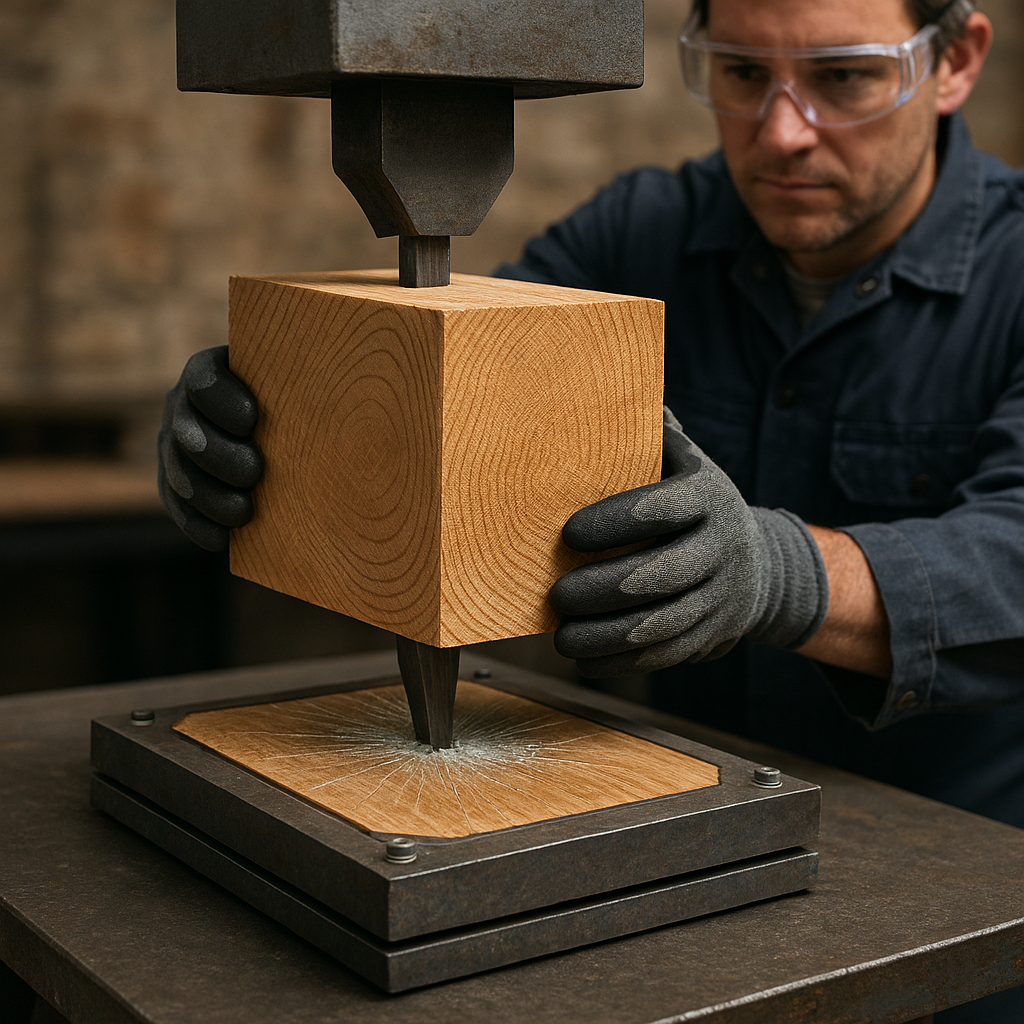Wooden Wonders: How Scientists Made Timber Tough Enough to Stop Bullets
In a world awash with high-tech composites, carbon fibre, and fortified steel, it is easy to underestimate the potential of humble wood. Since the earliest days of civilisation, wood has provided shelter, warmth, and tools, but few would look to their local oak as a serious contender for the job of bullet-stopper. That, however, might soon change thanks to a breakthrough by scientists working to transform renewable resources into something truly extraordinary: bulletproof wood.
Rethinking Nature’s Design
This remarkable leap blends material science know-how with ingenuity. For decades, team after team of researchers has sought ways to improve the properties of wood, making it stronger, more flexible, and more resilient to the rigours of modern life. Now, researchers at the University of Maryland—whose work is cited in recent announcements and builds upon earlier breakthroughs—have perfected a technique that could see wood take up roles usually reserved for steel and Kevlar.
At the heart of this process are two key steps: chemical treatment and compression. The first removes much of the lignin, a natural polymer that holds wood fibres together but can make wood brittle. Once stripped of lignin, what’s left is a cellulose-rich skeleton—light, flexible, and surprisingly strong. The next stage is to compress the treated wood under intense pressure, crushing the microstructure so that fibres align with minimal gaps between them.
What emerges is an unassuming wooden panel—yet its properties are anything but. Laboratory tests have already shown that these treated and compressed sheets can withstand the impact of bullets fired from a 9mm pistol, with rounds unable to fully penetrate when two such sheets are stacked together. The energy from the bullet is sapped away by the densely packed fibres, which are able to flatten, deform, and absorb the impact.
The Science Behind the Strength
Explaining the science further, this method exploits the inherent strength of cellulose—the fundamental building block of wood. Cellulose, in its pure form, can be stronger than certain types of steel by weight. By removing lignin and compressing the structure, the cellulose fibres are forced into closer contact, resulting in an ultra-dense, highly hydrogen-bonded network.
Research also confirms that this bullet-resistant timber can be made from various wood types, from common species like pine to more exotic hardwoods. The process is not limited to one source, allowing flexibility and potentially lower costs when the technique is scaled up.
Notably, the technology represents an evolution from previous advances in wood engineering. Over the past decade, scientists have modified wood for transparency, for enhanced thermal insulation, and even for conductivity. Each development has shown the possibilities inherent in nature’s designs—possibilities that modern science continues to unlock.
Green Armour: A Sustainable Solution
The environmental benefits of bulletproof wood are impossible to ignore. Traditional armour materials, whether in vehicles or vests, rely heavily on resource-intensive manufacturing, with high energy use and the extraction of metals or petroleum products. They are often difficult to recycle, leading to pollution and waste.
By contrast, the new material leverages the renewability of forests. Provided wood is sourced from sustainably managed plantations, it can be regrown and harvested repeatedly. Manufacturing bulletproof wood requires less energy compared to steel and ceramic composites, and, crucially, the end product is biodegradable.
Waste and by-products, if managed correctly, are far less toxic than those resulting from plastics and metals. As the world looks for ways to reduce carbon footprints, innovations like this could play a pivotal role not only in construction and design, but in reducing emissions associated with material production.
Applications: Beyond the Battlefield
While the phrase “bulletproof wood” conjures up images of personal body armour and military bunkers, the implications of this innovation stretch far wider.
Safer Buildings
In public and private architecture, the threat of ballistic attacks, extreme weather, and flying debris from storms is a growing concern. In the United States, schools and offices are already investing heavily in bullet-resistant panels, usually made from fibreglass or steel. Bulletproof wood could offer an alternative that is lighter, cheaper, and easier to install—especially in new buildings.
Moreover, wood’s natural aesthetics and its environmental credentials are attractive to contemporary architects. Where ugly steel panels might once have been hidden away, engineered timber panels could serve as both feature and shield.
Automotive Innovation
The car industry has long hunted for materials that balance safety and weight. Modern electric vehicles, in particular, are sensitive to mass due to battery considerations. Bulletproof wood could offer impact protection in select vehicle panels—useful for diplomatic vehicles, cash-in-transit vans, and security transports. It would be both less taxing on vehicle range and more eco-friendly than armour-plated steel.
Disaster Relief and Humanitarian Use
Natural disasters often bring with them not only environmental hazards but social instability. Quickly constructed, lightweight, bullet-resistant shelters made from treated timber could provide protection not only from the elements, but from violence and debris. For humanitarian groups, the ability to “grow” more building material and reduce transport costs could be transformative.
Industrial Sites and Critical Infrastructure
Industrial operations sometimes risk attacks, theft, or even accidents where protection from projectiles—be they bullets or flying fragments—is essential. Panels, walls, and barriers fashioned from bulletproof wood would provide robust, cost-effective solutions.
Obstacles and Open Questions
While the promises are significant, several hurdles must be overcome before bulletproof wood becomes a staple of modern construction and design.
Scaling Up: Current methods rely on specific chemical treatments, followed by intensive pressing. Achieving uniform quality at industrial scale will be necessary before wide adoption. Researchers are working to optimise the process for mass production.
Cost: Early prototypes of any revolutionary material are always expensive. As chemical methods become more efficient and as economies of scale are realised, costs are expected to drop—but at present, bulletproof wood is more expensive than untreated timber (and possibly even some competing ballistic materials).
Long-Term Durability: Most tests so far have focused on short-term performance under laboratory conditions. The long-term effects of moisture, UV light, fungal attack, and temperature swings remain to be fully understood, and researchers are racing to find protective coatings and treatments that can extend the life of bulletproof wood.
Sourcing and Sustainability: Although wood is renewable, there is a danger of over-exploitation if demand surges. Certification schemes and responsible forestry must be central to any large-scale deployment. The chemical processes involved, too, must be continually assessed to limit environmental harm.
The Bigger Picture: The Renaissance of Engineered Timber
The idea of treating and compressing wood to achieve superlative performance is not entirely new. Over the last century, plywood and laminated timber products have revolutionised construction and design. The new wave of “mass timber” construction—epitomised by cross-laminated timber (CLT) skyscrapers rising in London, Vienna, and Sydney—demonstrates how timber engineering has matured.
What sets bulletproof wood apart is its combination of lightweight structure and defensive capability. In the past, only heavily reinforced structures could withstand ballistic impact. Now, wood—arguably the most ancient of building materials—could compete head-to-head with the strongest modern materials, while offering far superior sustainability.
The Promise of Progress: What Comes Next?
Looking to the future, there are clear indications bulletproof wood is not simply a laboratory curiosity. Pilot projects are springing up at several universities and research institutes, including demonstrations of small shelters, wall panels, and potential applications in vehicle production.
To further its relevance, scientists are also experimenting with hybridisation—layering bulletproof wood with ceramics, fibreglass, or even transparent polymers, to achieve multi-functional protection (such as combining resistance to ballistic and fire threats). Other developments involve infusing the material with nanomaterials for enhanced weather resistance, or shaping panels that can be rapidly deployed in modular constructions.
Some researchers are keenly observing how the wood behaves after impact: instead of splintering dangerously, it can deform and, in some cases, even partially self-heal thanks to the interlocked fibres. This could mean not only better safety but also lower replacement costs after extreme events.
Global Implications
The introduction of bulletproof wood could have ramifications worldwide:
- Developed Countries: In urban environments, bulletproof wood could become part of the “defensive design” philosophy—where building elements double as protection from violence or disaster.
- Developing Nations: With careful investment, it could allow emerging economies to leapfrog to more secure, eco-friendly construction without the expense or logistics of importing heavy steel.
- Environmental Policy: Bulletproof wood supports global ambitions to decarbonise industries. If adoption grows, it could reduce reliance on CO2-intensive materials and make construction a carbon sink, not just a carbon source.
A Step into the Future, Rooted in the Past
If it sounds incredible, it’s because it is: the wood growing in forests today could literally be the stuff of tomorrow’s armour, simply by following a process inspired by both natural biology and the latest material science.
Not only does this material offer protection and sustainability, but it speaks to a wider trend in modern engineering—looking to nature for elegant solutions, and then tweaking them with human ingenuity. Timber, once dismissed as a relic in the arms race against modern threats, may soon be back in the fray, this time not just as a support beam or a decorative finish, but as the shield itself.
Conclusion: Redefining the Boundaries of the Possible
We stand on the edge of a timber renaissance. The development of bulletproof wood marks an extraordinary fusion of tradition and innovation—a synergy where renewable materials, scientific expertise, and the need for sustainable development meet. While much work remains to test, refine, and scale this technology, the foundation has been laid.
In coming years, don’t be surprised if public spaces, vehicles, and even homes gain new layers of safety—quietly, almost invisibly—cloaked in wooden panels engineered not just for comfort, but for survival.
So, next time you see a tree, consider this: it might just be growing tomorrow’s armour, patiently preparing for a future in which sustainability and protection go hand in hand.
References & Further Reading:
- BBC News: “Scientists create bulletproof wood”
- University of Maryland: Research on “super wood” properties and applications
- Science Advances, Hu et al. (2018): “Processing bulk natural wood into a high-performance structural material”
- The Guardian: Reports on mass timber and sustainable building
- International Panel on Climate Change (IPCC): Reports on material impacts on emissions



